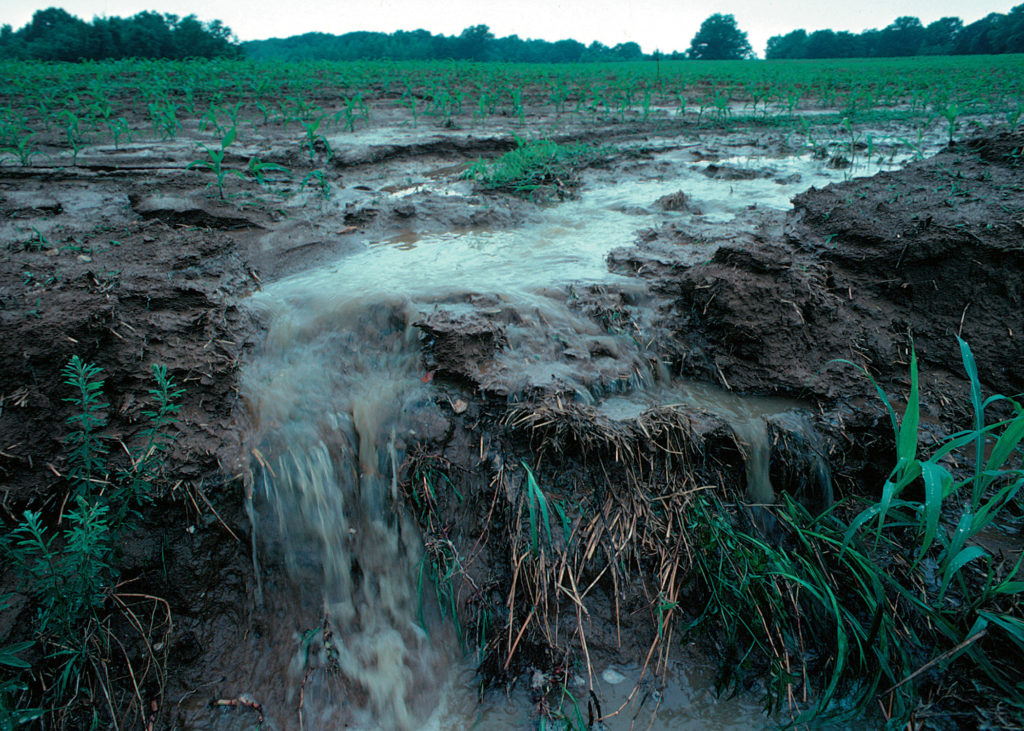Last month, Congressman David Young of Iowa introduced the Water Quality Conservation Act of 2017 (WQCA). The WQCA is a “marker bill” that seeks to address the issues of nutrient loss, soil erosion and runoff. According to the United Nations Food and Agriculture Organization, nutrient loss poses a major threat to agriculture and erosion presents the most significant threat of all.
Current farming practices seem to fall short when it comes to addressing nutrient loss and erosion. Allowing livestock to overgraze, ploughing semi-arid land to remove the grass, or leaving the land bare for part of the year—thus exposing it to the elements—all contribute to soil degradation. The WQCA seeks to address these issues by assisting producers in implementing the best conservation practices available to them by offering financial and educational support.

View of runoff, transporting non-point source pollution, from a farm field in Iowa during a rain storm. Source: US Department of Agriculture, Natural Resources Conservation Service.
The Act authorizes the Secretary of Agriculture to carry out a precision conservation pilot program, under which no more than ten states will receive grants to assist agricultural producers with projects aiming to increase nutrient retention in soil, reduce soil erosion while improving soil health, and enhance water quality. The pilot program first requires the identification of new and effective conservation practices, followed by the application of those practices at the watershed, sub-watershed, and field scales. Data is then collected on the effects of these practices on soil health, erosion reduction, nutrient runoff, and water quality.
Applications from states must include a description of how it plans to collaborate with other entities, such as producers, agricultural associations and local government, to carry out precision conservation programs. Applying states must also agree to give priority to assisting producers with projects in “critical conservation areas.”
These areas are designated based on the degree to which the area includes multiple states with significant agricultural production, is covered by an existing regional, state, binational, or multistate agreement plan, would benefit from improvement of water quantity and quality, and contains producers who need assistance in avoiding potentially environmentally damaging practices.
Participating states must match the grant amount for funding of these programs, and these funds may only be used to educate and recruit producers, provide assistance to those who elect to participate, monitor plan effectiveness, and encourage the use of precision agricultural technology.
This program offers something different from existing conservation or green payment programs in two ways. First, WQCA requires states to match the amount granted to them. This is meant to ensure leverage federal dollars and to help ensure compliance from the states through mandating an investment from them.
Second, the program places emphasis on educating producers regarding the most effective conservation practices rather than merely giving them funding. This focus on education will work to help producers understand more deeply the significance of nutrient loss and erosion as well as the most effective ways to address these problems.
The pilot program under the WQCA is to be monitored with state-submitted information. Participating states would be required to submit annual reports regarding the effectiveness of their plans as well as data to the Secretary of Agriculture. The Secretary will use this data from the states and up to $75,000 of the federal funds dedicated to the program to analyze program effectiveness and recommended conservation practices, which are to be published on a soil retention database.
WQCA incentives to improve conservation practices would offer an array of benefits to both producers and consumers as well as the environment. Water pollution is addressed through a focus on preventing sedimentation from erosion and runoff, while the program’s goal of increased nutrient retention offers the benefit of increased productivity to producers. Improved efficiency and operation through the use of innovative and effective technology and better management practices as a result of increased producer education will also benefit producers, while consumers benefit from the use of water with better quality on crops and as drinking water for livestock.
One concern of the WQCA is whether it would be cost-effective. If the impact is marginal, it may not be worth the amount of funding offered. However, this program addresses that concern through extensive and regular data collection from participating states to ensure that the plans are effective and on track with the stated goals of the WQCA.
Although the bill offers monetary incentive to participate in this program, educating producers and monitoring effectiveness make up two of the four allotted uses of its funds. It does not seek to merely pay producers to employ environmentally sustainable practices, but also to better inform them and raise awareness among the public through establishing a database with data collected from its monitoring. These focuses appear to be a step in the direction of offering non-monetary incentives to producers to take on conservation plans, thus allowing consumers, the environment, and producers themselves to reap the benefits.
Morgan Lynk is a JD student at Pace Law School.
